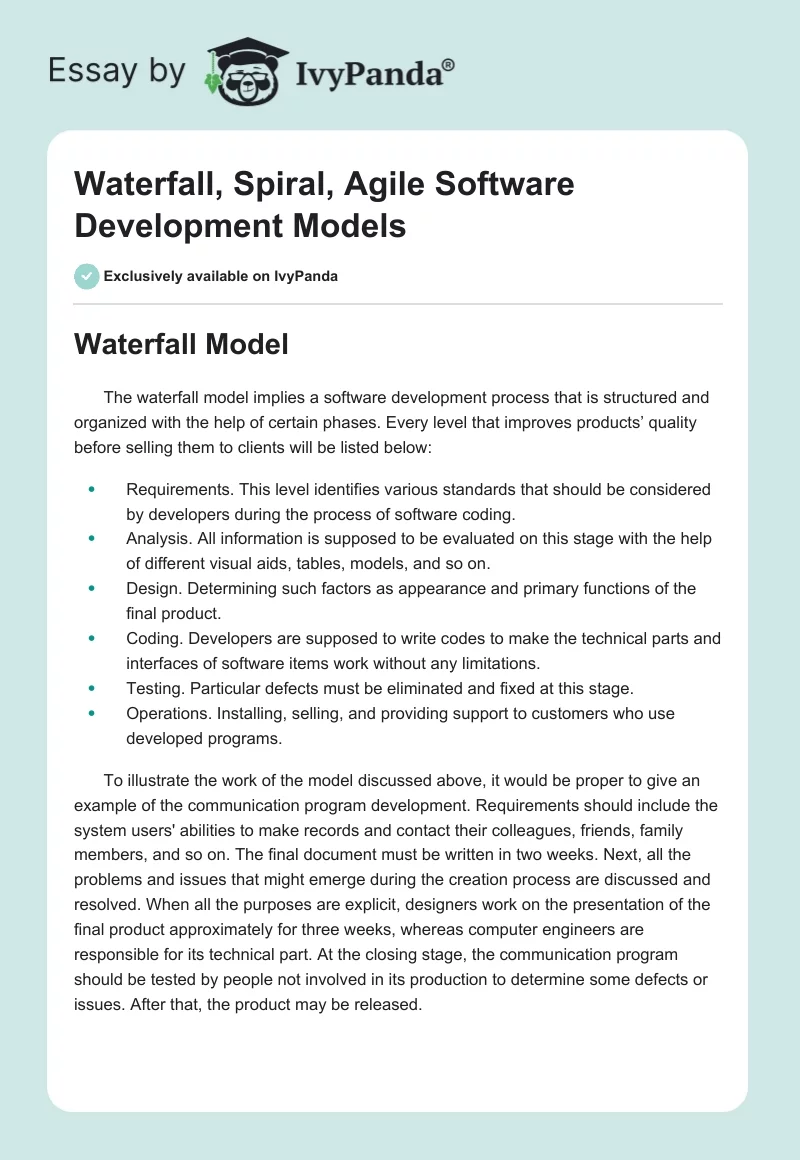Waterfall Model
The waterfall model implies a software development process that is structured and organized with the help of certain phases. Every level that improves products’ quality before selling them to clients will be listed below:
- Requirements. This level identifies various standards that should be considered by developers during the process of software coding.
- Analysis. All information is supposed to be evaluated on this stage with the help of different visual aids, tables, models, and so on.
- Design. Determining such factors as appearance and primary functions of the final product.
- Coding. Developers are supposed to write codes to make the technical parts and interfaces of software items work without any limitations.
- Testing. Particular defects must be eliminated and fixed at this stage.
- Operations. Installing, selling, and providing support to customers who use developed programs.
To illustrate the work of the model discussed above, it would be proper to give an example of the communication program development. Requirements should include the system users’ abilities to make records and contact their colleagues, friends, family members, and so on. The final document must be written in two weeks. Next, all the problems and issues that might emerge during the creation process are discussed and resolved. When all the purposes are explicit, designers work on the presentation of the final product approximately for three weeks, whereas computer engineers are responsible for its technical part. At the closing stage, the communication program should be tested by people not involved in its production to determine some defects or issues. After that, the product may be released.
Spiral Model
The spiral model invented by Barry Boehm in 1986 opened many opportunities for computer engineers in the process of software development. This workflow scheme contains both iterative and consecutive stages. This methodology is very helpful for determining as many mistakes in a final product as possible. Such control makes all the clients satisfied with the technical part and responsiveness of a certain software item. Also, Boehm outlined the most common risks that should be addressed at the first stage of product creation. The programmer suggests that all terms, finances, and developers’ skills should be evaluated with accuracy to avoid common misunderstandings among the working team’s members.
For instance, when creating an Internet browser, employees of an IT company should follow the four sectors of the spiral scheme (setting goals, evaluating and eliminating risks, development, and testing, planning the next iteration level). Each sector implies almost the same actions that have to be repeated over and over again to make future customers satisfied with the program’s intuitively clear interface, convenient work organization, and design.
Comparison Using Agile Development
The main ideas of the Agile Development methodology say that interaction and mutual understanding among colleagues is more important than available tools and resources. Also, the final product should be reliable and useful for solving particular tasks, regardless of the documentation provided for the project. People should address every primary need of customers without focusing on various requirements described in the contract previously. In the end, all computer engineers must be ready to accept and agree to unexpected changes at any moment. This quality is more valuable than people’s ability to follow initial plans.
The Spiral and Waterfall models discussed above have different approaches to identical tasks. However, the Spiral method is more flexible and meets more Agile Development ideas than the Waterfall plan. Moreover, the Spiral methodology is more common in software companies as it implies a thorough elaboration and testing of different products on every stage of their creation process. Agile Development would be well suited to the example of the Internet browser coding as this project aims at interacting with clients and users in the future. Also, the same methodology should be considered in the case of communication program development as its processes are responsible for decent audio and video connections. Such a strategy is essential for the software products mentioned above as it should be understandable for regular users.
Appropriateness of Agile Development Use
Agile Development methodology would be appropriate to use when the developer is required to adjust to certain changes and customers’ requests. Many people want the product they order to include every function and design they expect. As this task is almost impossible to accomplish without additional recommendations, all needs and requirements should be considered to create high-quality programs.
Also, the methodology described above is useful for developing perfect products. Since every aspect is tested, reorganized, and improved several times, there is almost no possibility to provide users with services overwhelmed with defects. Also, the client has a chance to check one’s order on every stage of its creation. This lets people be sure that they pay for what they want and expect. With the help of this strategy, any client can communicate with the hired team daily to control its results.


